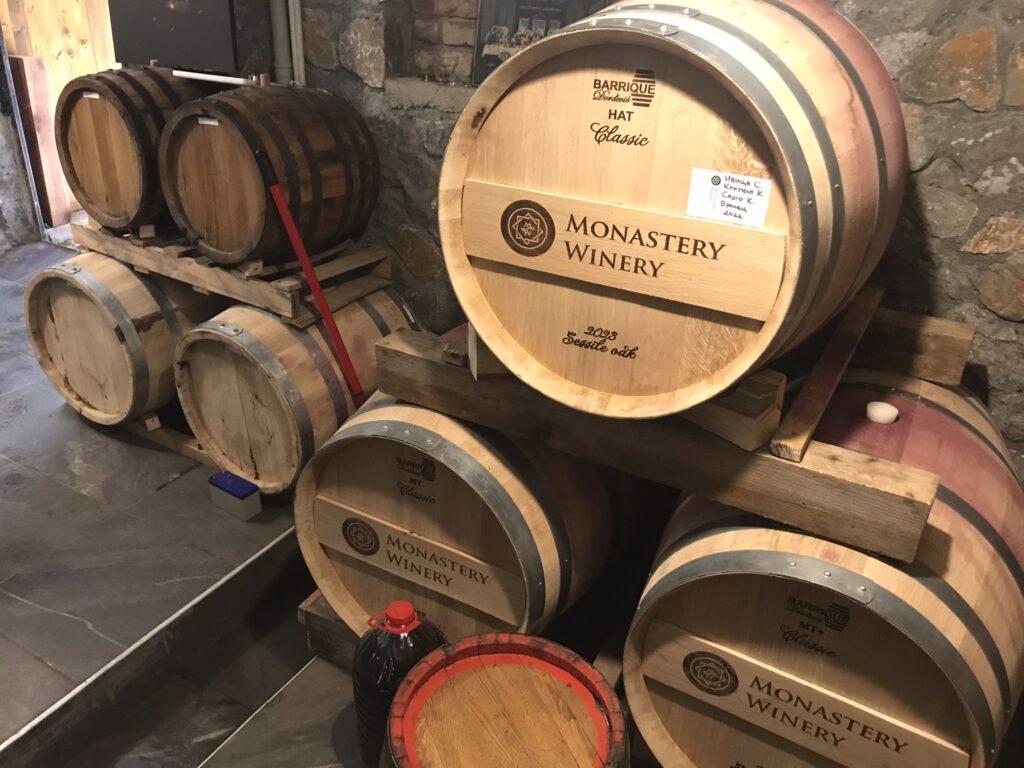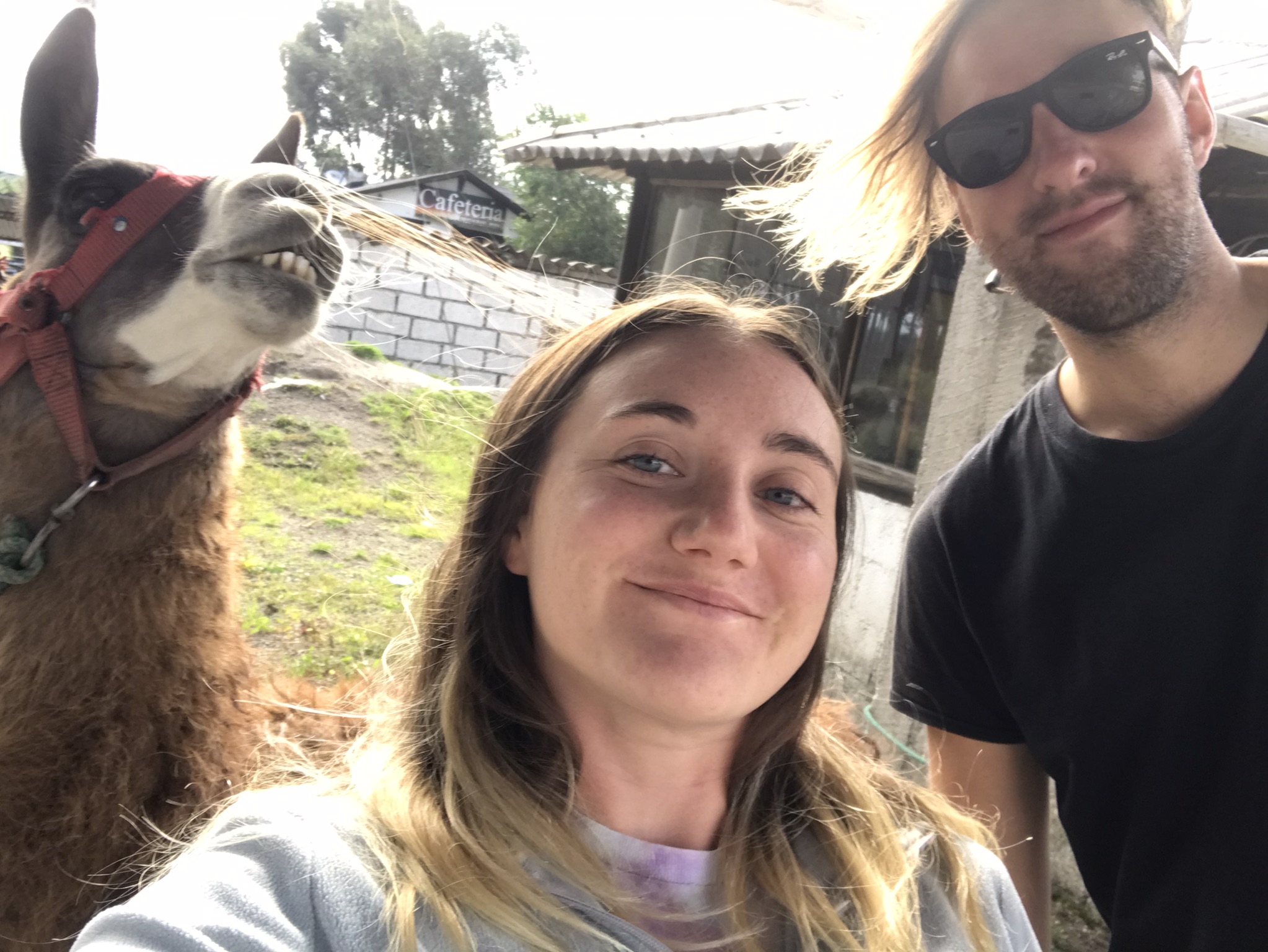North Macedonia may be one of the smallest and least-known countries in Europe but, while our North Macedonia travel itinerary only took in three stops, we found it to be a varied country which was inexpensive, easy to get around and full of surprises.
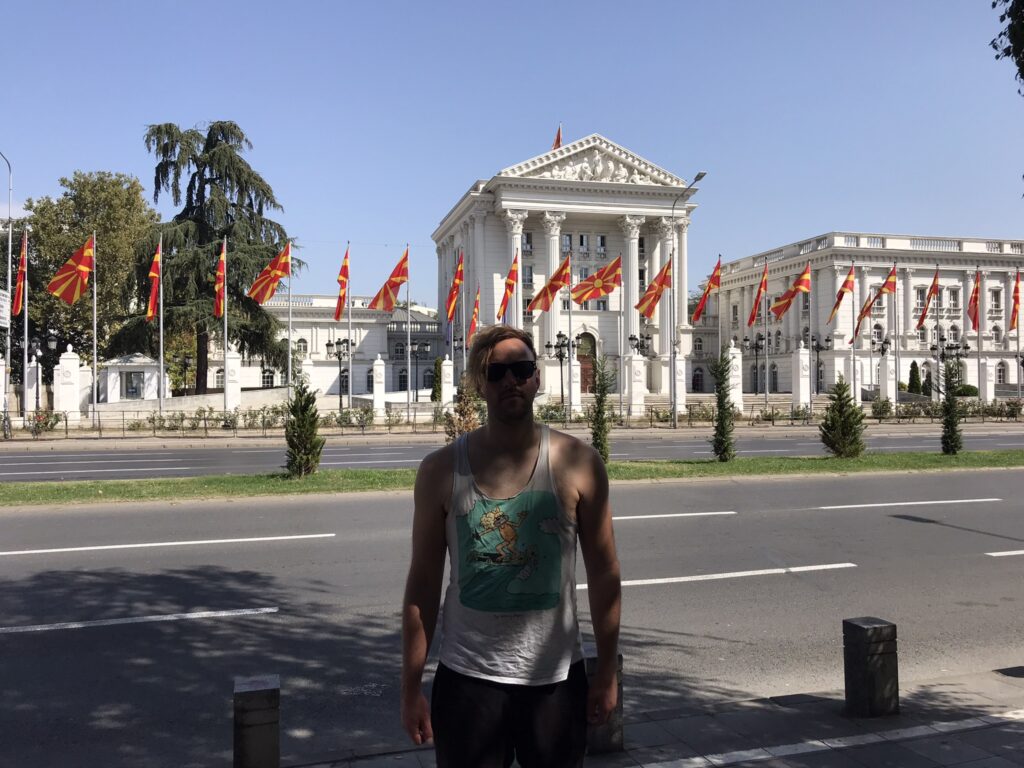
Some would say that North Macedonia is in the middle of an identity crisis. North Macedonians will tell you that their country was once the Kingdom of Macedon with its most famous ruler being Alexander the Great. This is not totally false as the region was incorporated into the Kingdom of Macedonia in the 4th century BC, however the region of Macedonia in Greece is typically accepted to be the centre of the original Kingdom of Macedonia. Many North Macedonians also claim that their people are the real descendants of Alexander the Great. However it’s been proven by experts that the majority of North Macedonians are actually of Slavic ancestry due to the great migration of the Slavic peoples south in the 6th century. Still, ownership of the Macedonian identity and Alexander the Great is a long-running argument between North Macedonia and Greece. Greece has accused North Macedonia of rewriting their own history and forging a national identity that isn’t completely historically true. They further accuse North Macedonia of misappropriating Greek cultural symbols and figures, such as the national flag featuring the Vergina Sun and countless statues of Alexander the Great dotted about in Skopje.
It’s also important to note that North Macedonians don’t refer to themselves as such, they simply refer to themselves as Macedonians and their country as Macedonia. You might find yourself in hot water if you slip up and call the country North Macedonia in front of a local. Prior to 2018, North Macedonia was named the Republic of Macedonia, much to the chagrin and irritation of neighbouring Greece who demanded that the country was known as the Former Yugoslav Republic of Macedonia on the international stage to avoid confusion with their own region of Macedonia. The name change to North Macedonia was a compromise, pressured by Greece, as they continually blocked North Macedonia’s entry into the European Union. It’s still a very controversial and raw subject for North Macedonian citizens. Many North Macedonians will tell you that they’ve sold their soul to Greece for EU membership, some thoroughly oppose EU membership solely due to the forced name change and also the fact that they still haven’t been accepted into the EU despite these compromises. North Macedonia also has two national flags with very similar designs, one being the ‘old’ flag which was changed due to international pressure. Not everyone is a fan of the new national flag, since its introduction some citizens still use the old one and you can see it proudly displayed atop homes around the country. This coexistence of two national flags is definitely unusual.
Interestingly, North Macedonia was the birthplace of Mother Teresa, who was born and grew up in Skopje between 1910 – 1928. You can visit the Memorial House of Mother Teresa and check out personal belongings like her bed and clothes alongside a photo gallery charting her life from childhood to later life. Both Kosovo and Albania also stake a claim to Mother Teresa as her parents were originally from Kosovo and ethnic Albanians.
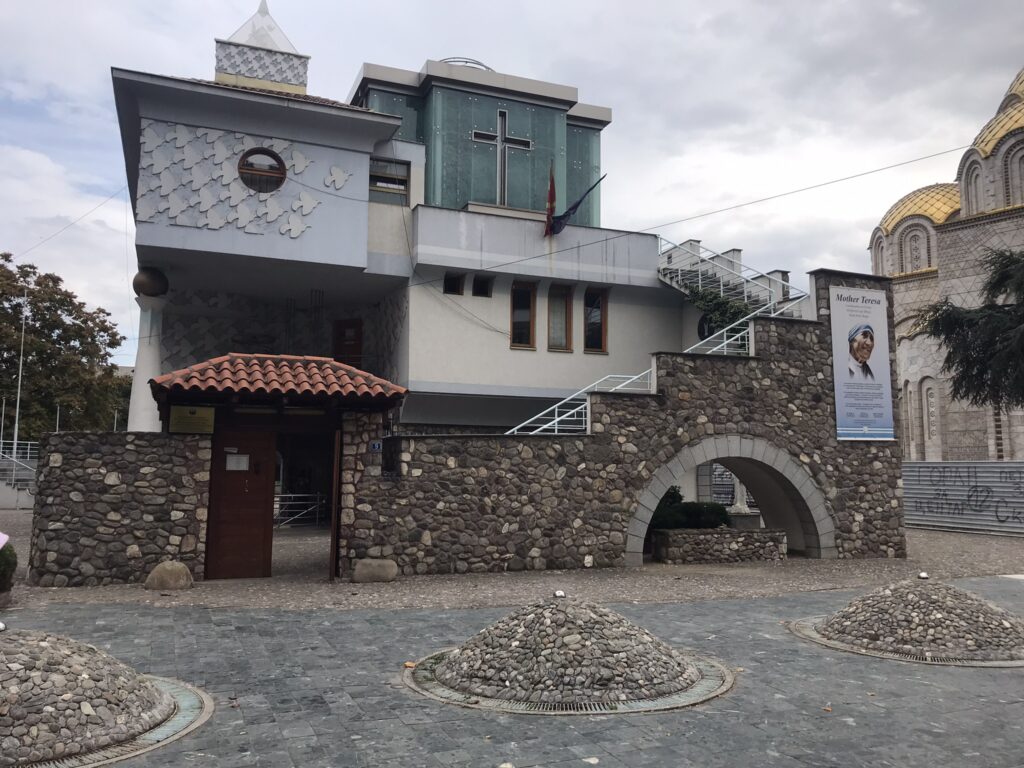
The Mother Teresa memorial house in Skopje
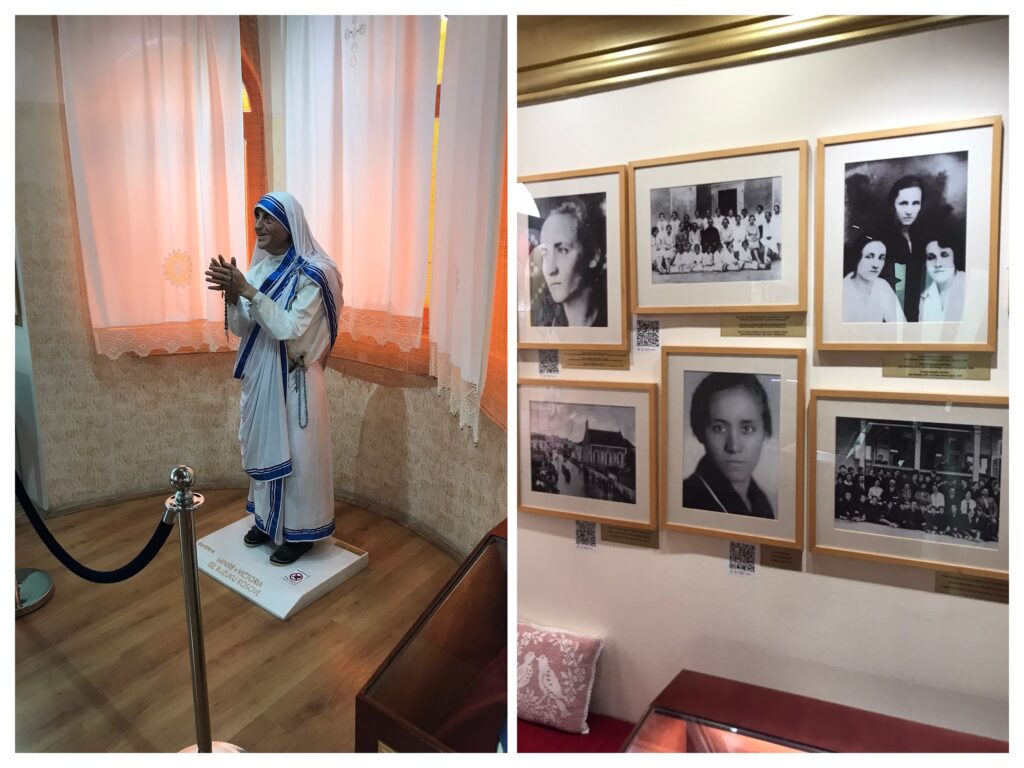
Unlike in much of the Balkans, the water throughout most of North Macedonia is safe to drink. The country prides itself on having some of the best water in Europe, they even claim to have won an award for the best Coca-Cola in the world due to the purity of Macedonian water used to make it. The purity of North Macedonian water is a source of national pride.
Skopje
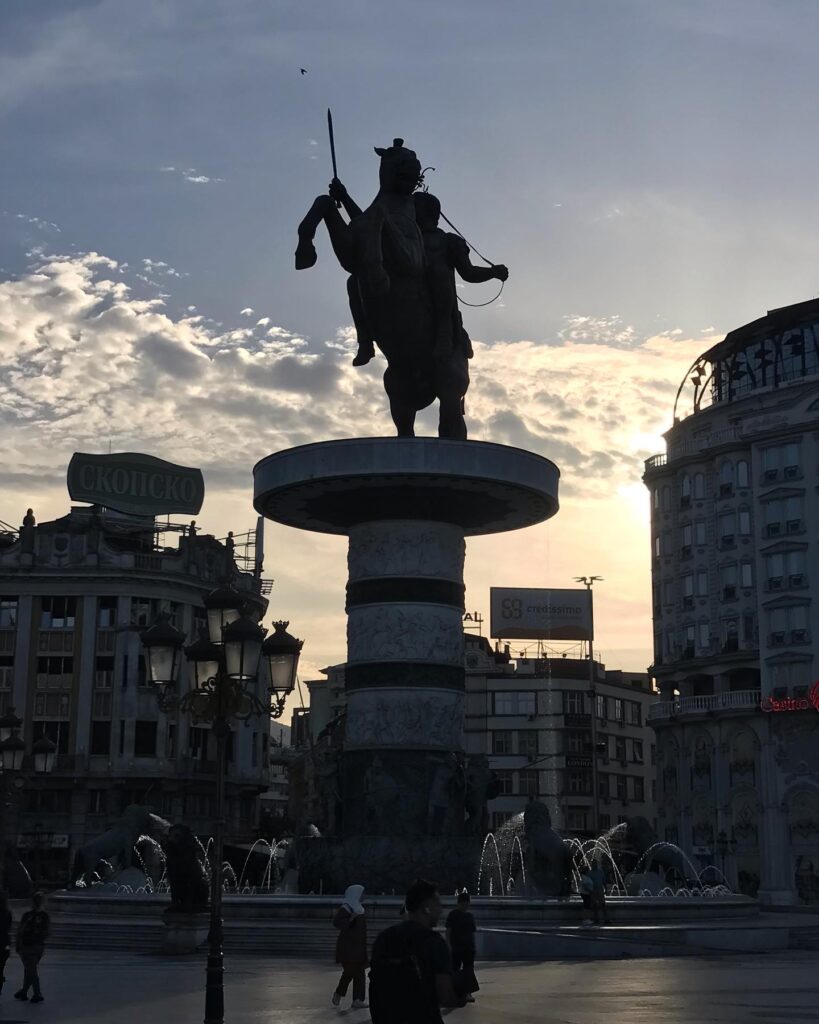
With its striking grand neo-classical white marble buildings which glisten in the sunlight to the numerous antique-looking brass statues lining the Bridge of Civilisation and the massive statues of Alexander the Great and Philip II of Macedon proudly facing each other across the Vardar river, one could be mistaken for thinking they’d stumbled into an historic capital city brimming with ancient legacy. It’s shocking to realise that all the Greek-looking monuments and statues are actually a modern creation of the 21st century. While this is controversial, it certainly gives Skopje a grand and unique feel befitting a monumental capital city. We were surprised to find Skopje crammed with tourists – it’s not the usual holiday destination or European city break, but there were plenty of foreign visitors here. Watch your step for one of the many bikes and electric scooters zipping around the city centre, they don’t stick to the cycle lanes so be prepared to dodge a rogue scooter in pedestrian areas.
Accommodation
An Airbnb apartment about 10 minutes walk away from Macedonia Square near the Orthodox Church of Saint Clement of Ohrid.
Foodie Places
Chardak – a lively, less formal restaurant with outdoor seating. We were treated to a performance by a live band and a group of drunken men at one of the tables singing what seemed to be patriotic ballads whilst drinking copious amounts of alcohol. At points we couldn’t tell who was in the band and who was a paying customer in the group. It made for an interesting night’s entertainment. This seemed to be normal for a Friday night in a lot of Skopje restaurants, expect loud singing! This might not be the place to go if you’re looking for a quiet, intimate setting.
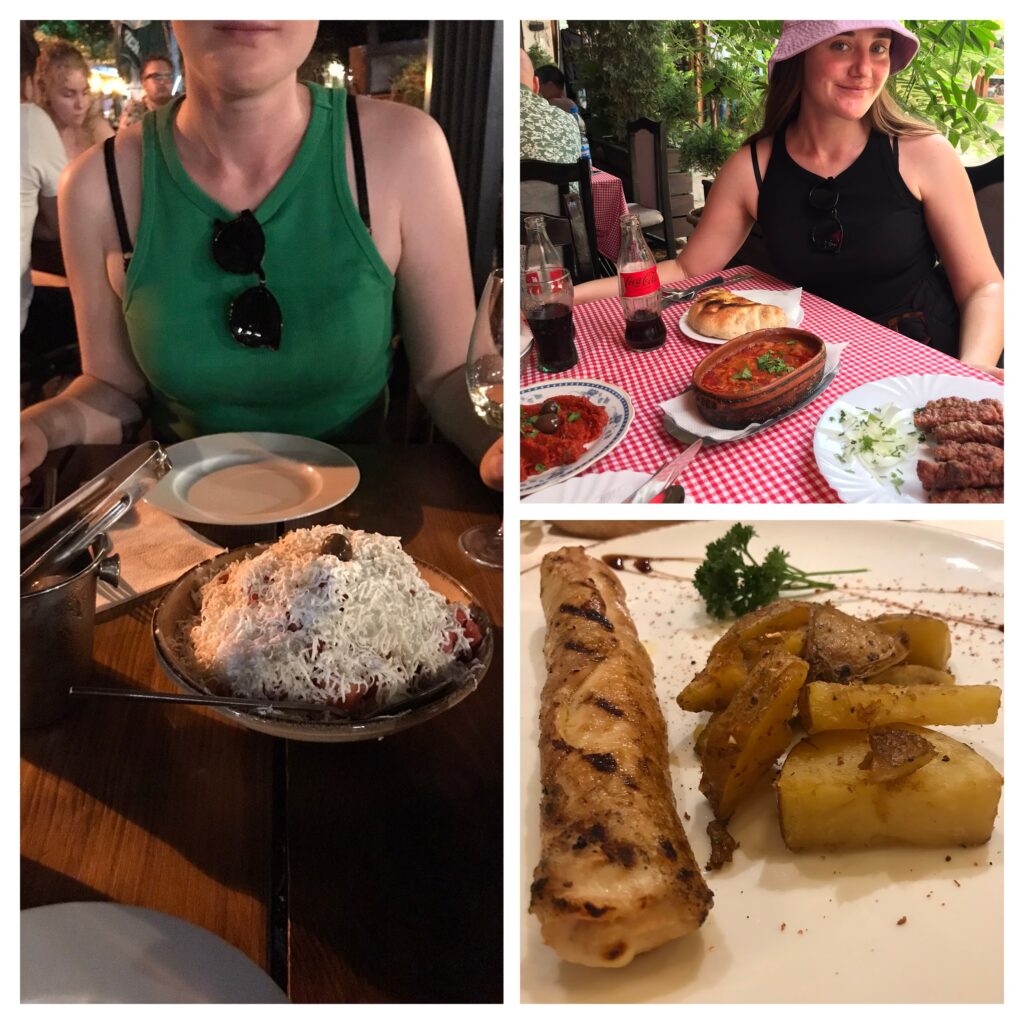
We loved the Macedonian food. Clockwise from left: Enjoying a skopska salad at Chardak, tavče gravče at Cebapchilnica Turist and delicious meal at Skopski Merak.
Restaurant Skopski Merak – serving Balkan classics in a suave setting with a more polished live band, slightly more upmarket than Chardak. The food was excellent, especially the sarma and the rolled chicken stuffed with cheese.
Subzy – decent sandwiches, Subway-style and they do delivery too.
Restaurants in the Old Bazaar – we grabbed some cevapi and a beer from the restaurant ‘Cebapchilnica Turist’, we also tried tavče gravče, similar to spicy baked beans, which is the national dish of North Macedonia. The restaurants in the Old Bazaar are very touristic, be careful as they may try to overcharge you. We enjoyed the experience of eating here though.
Activities
Free walking tour with Guruwalk – a fantastic introduction to all things (North) Macedonian!
Some of the stops include:
Old Bazaar – a great place to shop for souvenirs, grab a bite to eat or chat over a Turkish coffee. Step into Ottoman Skopje by visiting the Old Bazaar; some claim it’s the oldest Bazaar in the Balkans. Once a centre for trade and commerce with products from the far corners of the Ottoman empire and beyond, the Old Bazaar area is now a major tourist attraction with Turkish coffee houses and grill restaurants. You can still find streets dedicated to certain trades like gold-working.
Macedonian Orthodox Church Ascension of Jesus – you have to pay an entrance fee to enter the church, a guide will give a short explanation about certain interesting features. I made a bit of an idiot of myself here as I approached a woman who I thought was the guide and asked her a question, only to find out that she wasn’t the guide and was just giving a short explanation to her American friends. Oops! The complex also includes the tomb of North Macedonia’s national hero Gotse Delchev, as well as a small museum about the nation’s independence and Delchev’s role in that.
Skopje Fortress – free entrance with great panoramic views over the city. Don’t expect a restored, touristic fortress, you get what you pay for here as much of the interior is overgrown and strewn with rubbish, and some of the walkways are partially collapsed. The fortress felt way more authentic though because of this.
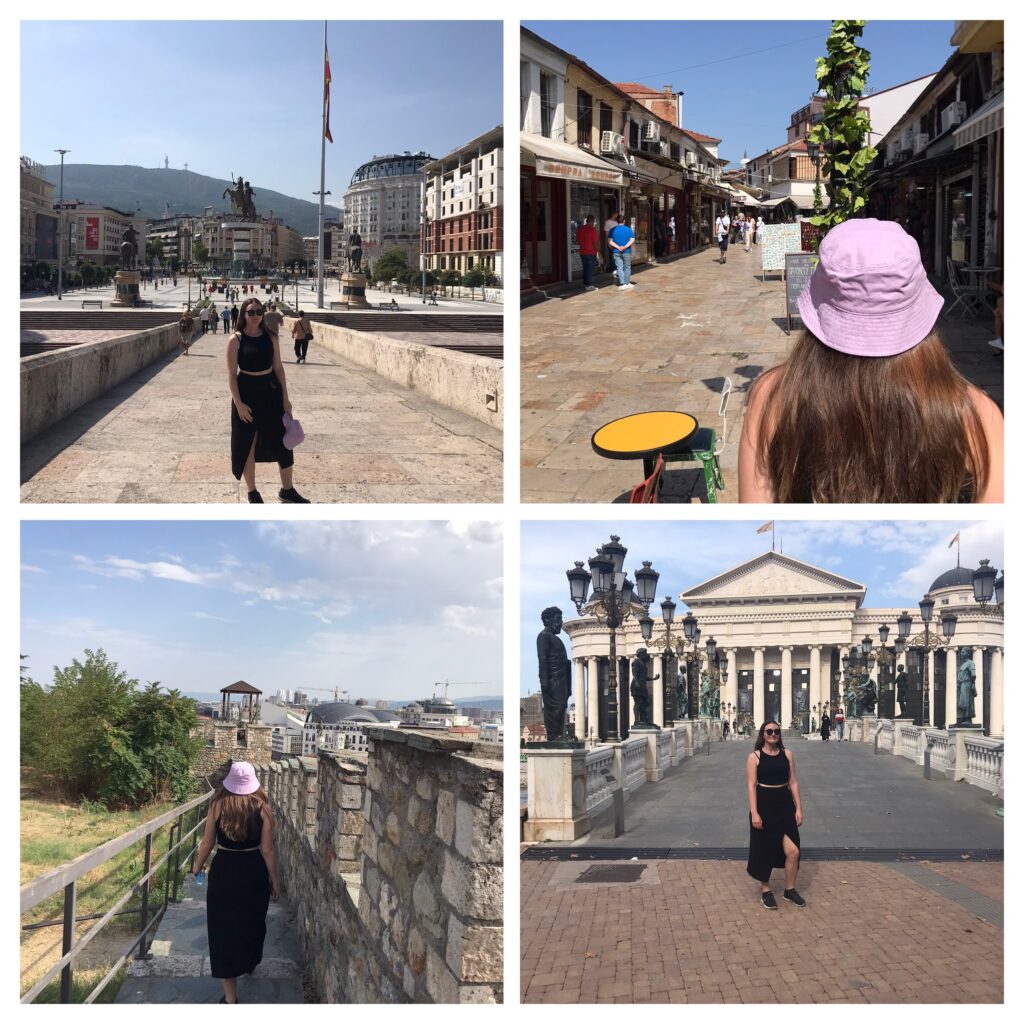
The grand tour in Skopje!
The Stone Bridge, the Bridge of Civilisations, Philip II Square, Macedonia Square, Triumph Arch Macedonia – all of these are great places to admire Skopje’s somewhat garish Greek-style statues and monuments
Mother Teresa Memorial House – free admission with a small museum dedicated to Mother Teresa, her upbringing in Skopje and later life as a world-famous celebrity.
Museum of the City – previously the railway station before it was partially destroyed by the 1963 earthquake, some of the people who died inside the building are now buried in graves outside the museum. Spooky! Free admission with a collection of historical artifacts.
This is a slightly quirky suggestion but we really enjoyed watching Macedonian TV shows, in particular a series from the 90’s featuring an odd mountain man who lived in a hut with his dog and 3 children and a scuba-diver in the closing credits. We couldn’t understand a word but the show was very entertaining by modern standards; we tried to make time every morning to catch the next episode.
Day trip to Matka canyon – located just outside the city, Matka canyon is a picturesque canyon landscape with the Treska river running through it. You can either hike along the edge of the canyon by following the trail or book a boat trip along the river. We were advised not to go with the first boat tour operator at the entrance but instead book tickets with the second boat tour company, as this was a more extensive trip featuring a stop at the Vrelo cave. There are funky coloured lights inside the cave which cast interesting shadows on the stalactites and stalagmites. Overall the boat trip was tranquil and peaceful. While waiting for the boat we encountered a friendly man with a large collection of military-grade hunting knives and other weapons, which he wanted to demonstrate and said were for sale.

On the water and in the cave at Matka
To reach Matka canyon, take the number 60 bus from Skopje (Мост Гоце Делчев bus stop next to the Fortress). Be aware that the buses did not run on time when we were there, we waited ages for the bus and didn’t know what side of the road to wait on; we ended up missing the bus as we were on the wrong side of the road. Be patient and eventually the bus will come. You need to be on the side of the road closest to the Fortress. The bus might drop you off here (60 bus stop at matka canyon) instead of at the entrance to the canyon, this is just a short walk from the entrance. Make sure you wait at this location to be picked up as some travelers have reported missing the bus as they waited in the wrong place.
Bitola
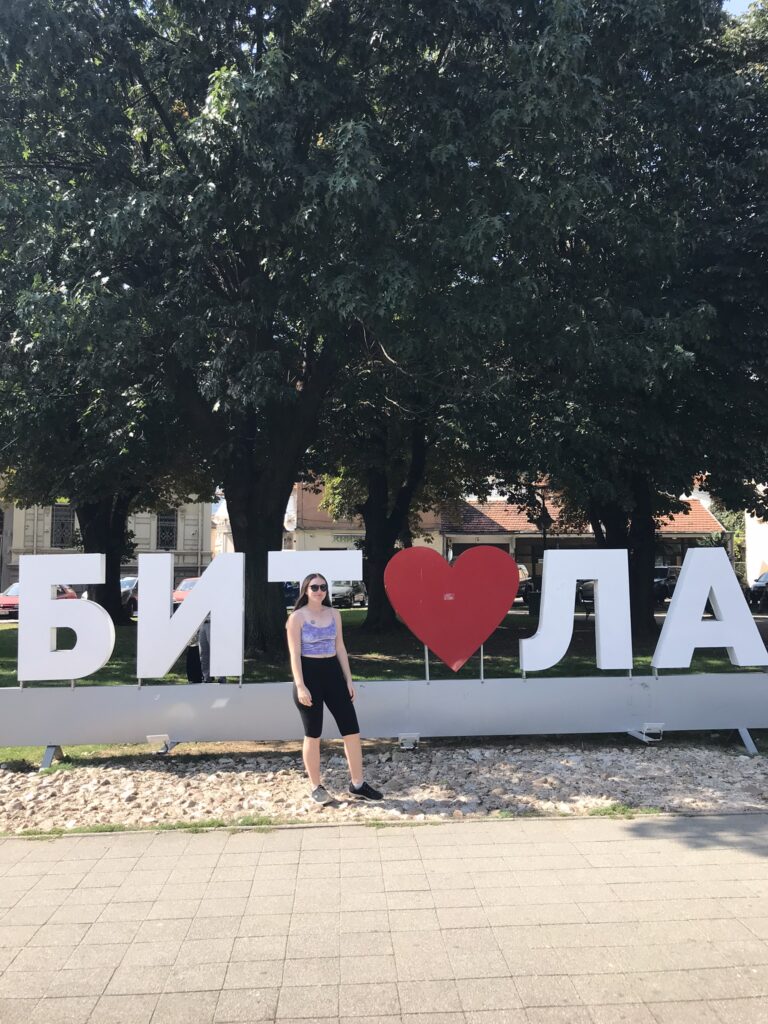
One of the oldest cities in North Macedonia and the second largest city in North Macedonia. Bitola is surprisingly off the beaten track for tourists and we felt like some of the only foreigners in town. The main reason to visit this city is to explore the ruins of Heraclea Lyncestis or the nearby mountains and national park. Heraclea Lyncestis was originally a Greek settlement founded by Philip II of Macedon (Alexander the Great’s father), Romans then took control of the city and added various public works with the Emperor Hadrian commissioning a theater which is still visible at the archeological site today. If you’re a history nerd like me then I highly recommend visiting the Heraclea Lyncestis site as there are some fantastic intact mosaics, the remains of some very early churches with early Christian mosaics and marble columns still in situ. The site is walkable from the centre of Bitola, there’s also an online audio guide available and free wifi so you can listen to the guide, it’s very informative and really helps you to imagine what the city would’ve looked like during its heyday. In the city centre, the clock tower is worth checking out too. The centre of Bitola is small but we found it to be quite clean, vibrant and prosperous, there was even an international film festival taking place while we were there. However we did find that there were surprisingly few options for food – what looked like masses of restaurants lining the main street were actually all just serving coffee!
Check out my walking tour guide of Bitola here!
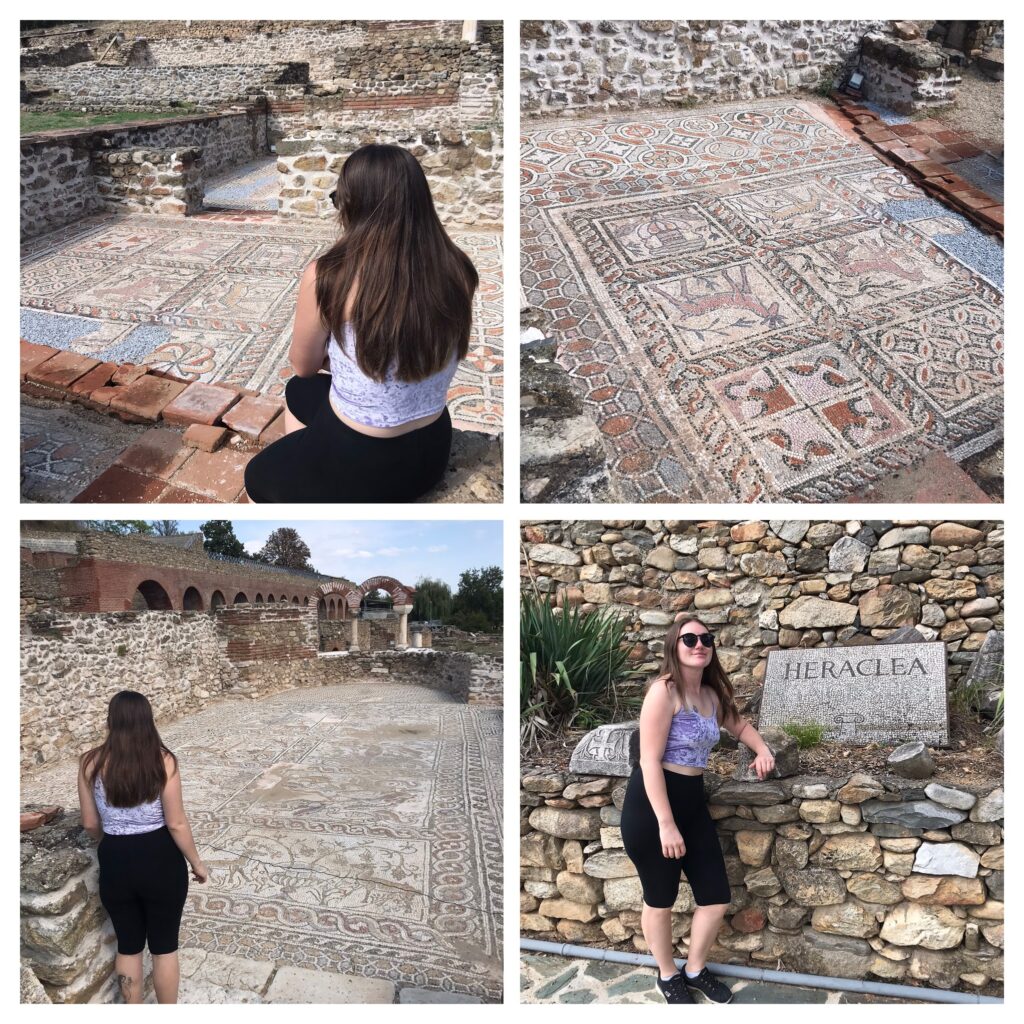
The mosaics at Heraclea are definitely a highlight
Accommodation
Nestor Apartments – I highly recommend Nestor Apartments, the room was clean, spacious and came with cable TV. The host was exceptionally friendly and welcoming, he greeted us like old friends and we had a long chat with him over coffee. The location is excellent too, situated just off the main pedestrian street, Shirok Sokak. The kitchen had everything you need to cook and we even helped ourselves to some Turkish coffee. The host even let us use his washing machine, which was an absolute life-saver.

Downtown Bitola
Foodie Places
Kus Kus – Italian restaurant serving Italian classics like pizza and pasta, we particularly enjoyed the chicken sandwich which was very cheap and tasty!
Vino bar Bure – As the name suggests there’s a great variety of local wines to choose from. With outdoor seating in the square, this was a great spot for dinner.
Bakery Boulevard – bread heaven! This is the ideal place to stop for a quick, cheap lunch, they even have my personal favourite, hot dog in a roll alongside sandwiches and other baked goods. Everything looked very tasty.
Ohrid
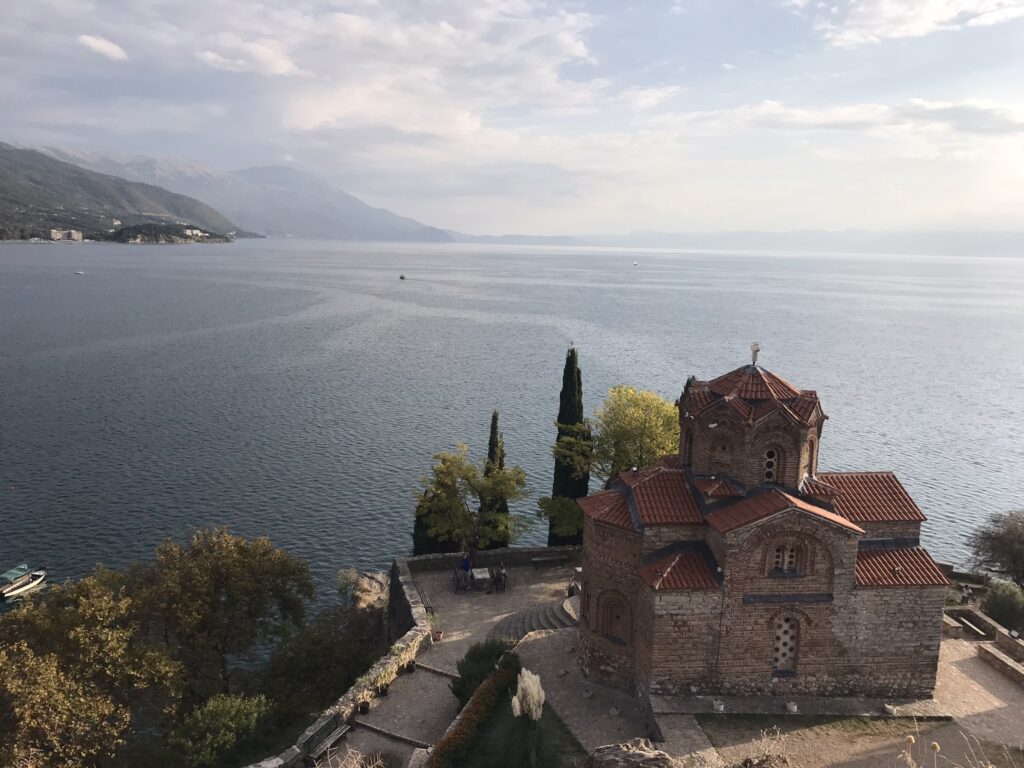
Ohrid is situated on a steep hill with beautiful sweeping views over Lake Ohrid. These spectacular vistas come at a cost, a demanding uphill walk on cobblestone roads. Lake Ohrid straddles both North Macedonia and Albania. You are not able to drive, park or get a taxi in the historic centre so reaching your accommodation can be challenging if you bring a wheelie suitcase like me! You still need to keep an eye out for locals who have a permit to drive their car around the narrow, windy streets as they will try to pass you and expect you to jump out of the way. However Ohrid is by no means horrid, there’s plenty to keep you busy – from hiking to Samuel’s Fortress and St John the Theologian Church on the cliff top to visiting nearby Macedonian wineries or taking a boat trip across Lake Ohrid to St Naum Monastery.
Ohrid was the first place that we encountered the phenomenon of having to pay entry for churches. Prior to this we’d always just walked in and paid nothing. I have mixed feelings about paying money to enter a church, on one hand I understand that funds are needed for the upkeep of the church and any artifacts housed within but it just feels so strange. With the large number of churches in Ohrid, paying entry for every one meant money would start mounting up. With this in mind, we had to do our best to admire some of the churches such as St Sophia and St John the Theologian from the outside.
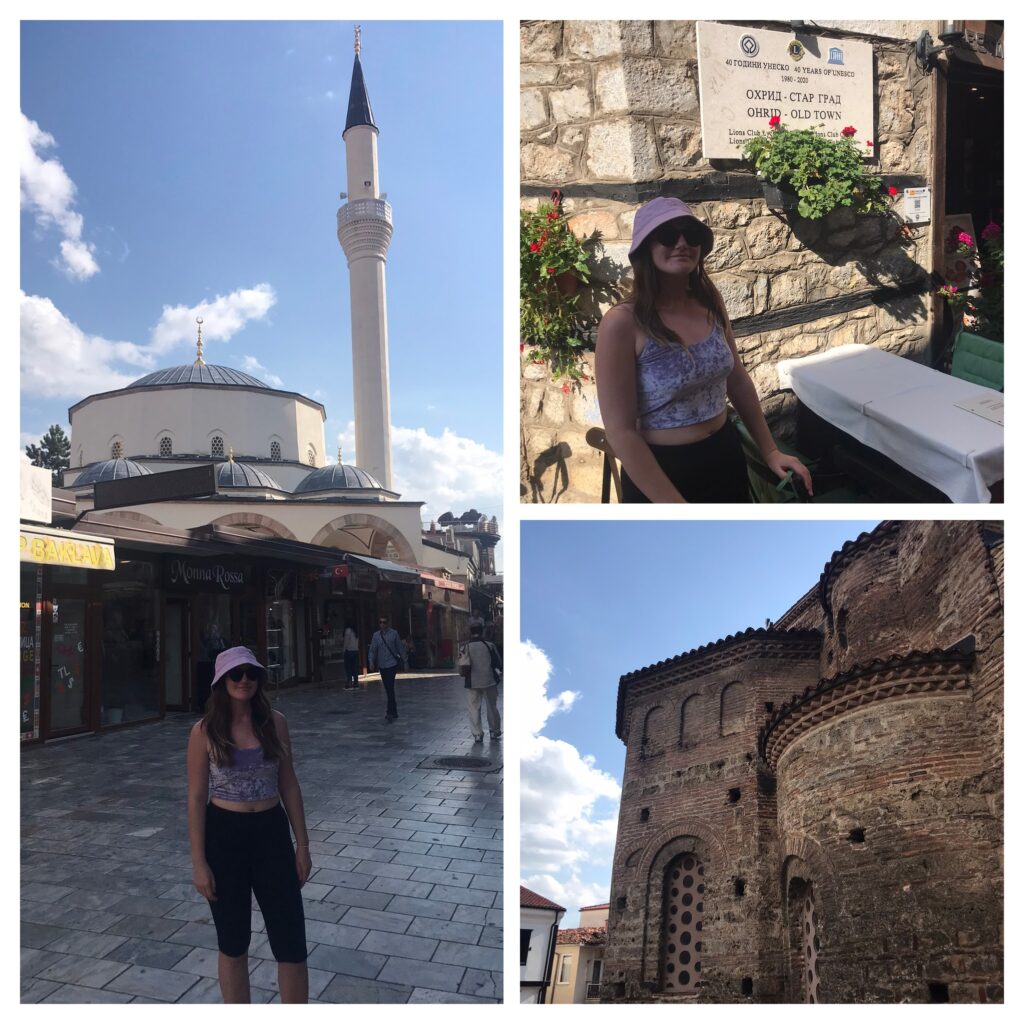
St Sofia Church and the Bazaar
Ohrid is by far the most popular tourist destination in North Macedonia. It’s important to note that Ohrid is generally more expensive than Skopje, especially eating out, however it’s possible to find cheaper restaurants. A top tip when it comes to finding budget restaurants is to avoid touristy areas such as the Old Town and seafront as these usually cater to a more affluent crowd due to their prime location. There were plenty of good options frequented by locals if you walked a little further from the centre.
Accommodation
Villa Dvor Ohrid – not the easiest place to reach with a wheelie suitcase due to the many stairs and cobblestone streets, expect to sweat a lot and maybe even swear! I learned my lesson after bringing a wheelie suitcase here. The accommodation was pleasant though, there’s a fully equipped kitchen with coffee available for all guests to use. The room was clean and spacious with Netflix on the tv.
Foodie Places
Bro’s Burger Station – hipster joint serving tasty burgers for a good price in the Old Town.
Bakery Lihnida – a great selection of baked goods to choose from, make sure you bring cash with you as they don’t take card payments

Gostilnica Neim – this was a restaurant outside of the tourist area, the decor was garish, we were the only people in there and the owner was a bit of a character but the portions were huge and the food was much more affordable, unlike many of the more high-end establishments by the lakefront. Many meat variations and Macedonian classics on the menu.
Activities
Self guided walking tour with GPSmycity, including the stops below:
Ohrid Boardwalk – a nice place to catch the last rays of the setting sun.
Saint Sofia Church – one of the most important monuments in North Macedonia, entry will set you back by a couple of pounds.
St John the Theologian Church – a very popular tourist spot, the church is situated on a cliff top overlooking Lake Ohrid, this is a great place for a photo or to watch the sunset.
City Walls & Samuel’s Fortress – a great lookout point with spectacular views of the city and Lake Ohrid, you need to pay a small entrance fee to enter the fortress.
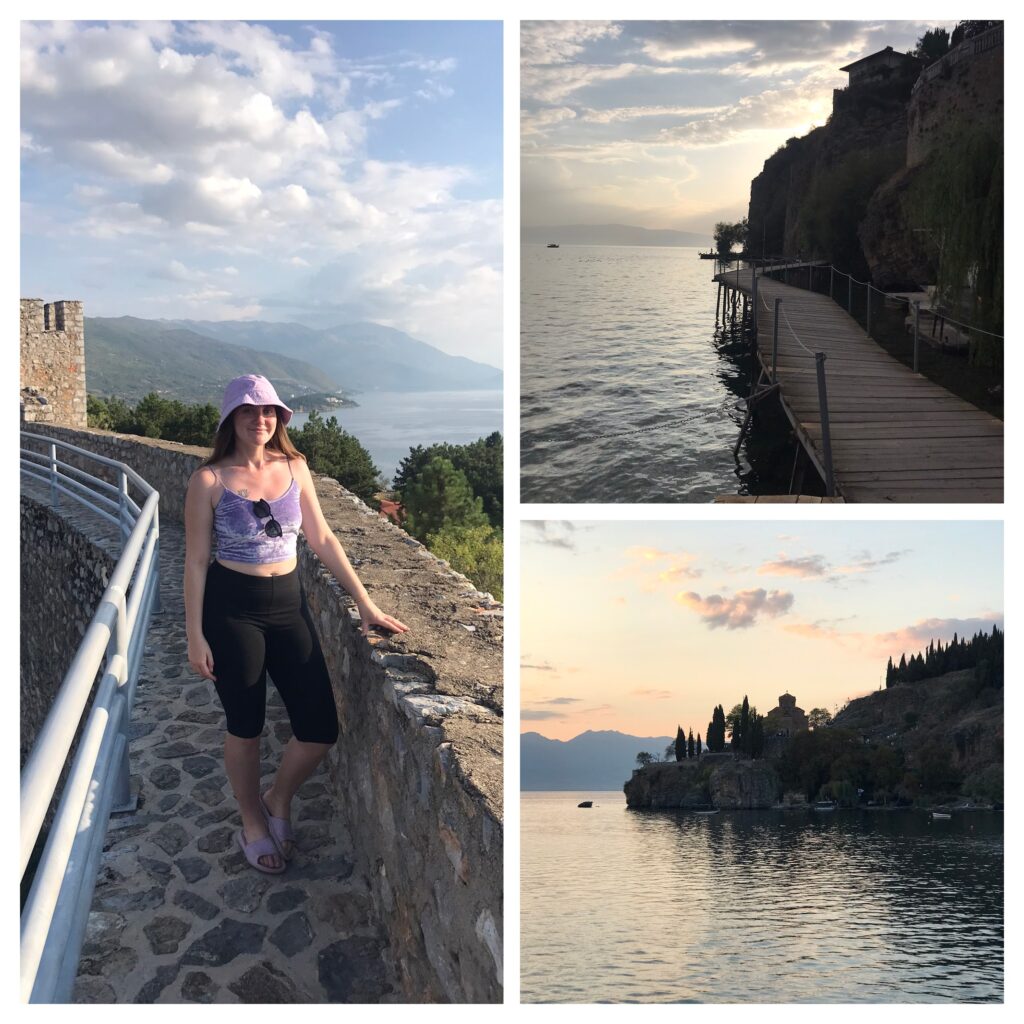
Ancient Macedonian Theatre of Ohrid – free admission.
National Workshop for Handmade Paper – a shop using traditional techniques and a 15th century Gutenberg press to make paper, there’s only 3 Gutenberg presses left in the world, it also doubles as a shop selling handmade paper, we looked inside for a while and were greeted by the owner but there’s no pressure to buy any of the handmade paper they produce.
City Square – the main meeting point of the city.
Old Bazaar street
Port of Ohrid – this is the place where boat trips leave for St Naum Monastery, you’ll find street hawkers trying to sell these boat trips.
Mosque of Ali Pasha – a slice of Ottoman history close to the Bazaar.
Armada Sunset cruise booked through Tripadvisor – what better way to enjoy the sunset across Lake Ohrid than on a romantic sunset cruise with a glass of champagne (probably prosecco) in hand. It’s possible to buy extra drinks after the complimentary glass of bubbly but we resisted the urge to splurge. The views of Lake Ohrid, St John the Theologian Church and Ohrid itself at sunset are stunning. The vibe is very romantic and coupley with power ballads playing in the background, so I would think twice about going if you are on your own. We saw a couple of people on their own and they looked a tad lonely/left out.
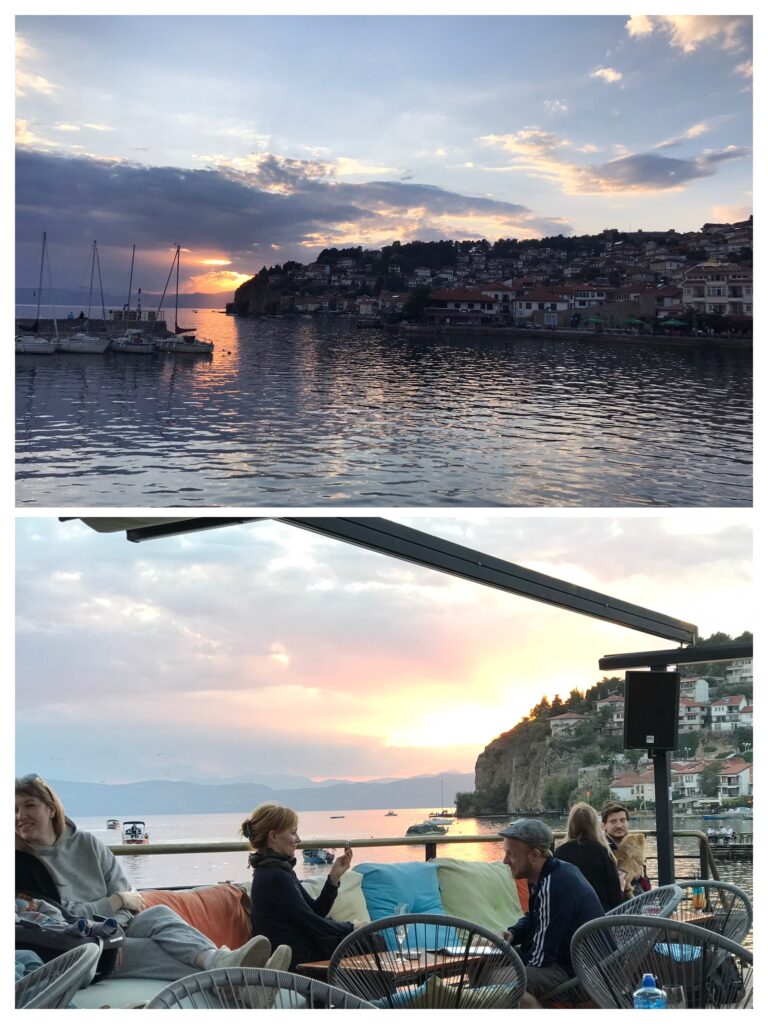
Our sophisticated sunset cruise
Boat trip to St Naum Monastery & Bay of Bones – You can grab some lunch at the nearby bakery Lihnida before boarding the boat if you’re on a budget. There are some restaurants at St Naum but I would guess they’re more on the expensive side due to their remote location. Make sure you arrive early to get a good seat on the boat, ideally closest to the water so no one is obstructing your view. I was blown away by how crystal clear the water was in Lake Ohrid, the water was almost sapphire in colour. It was great to relax and take in the views of the Lake and the coastline as we slowly passed by. The first stop is the Bay of Bones which is a floating reconstructed village of stilt houses displaying Bronze & Iron Age items recovered from Lake Ohrid. There isn’t much time to explore this museum on the boat trip (we got only 20 minutes in total) so we opted not to pay the entry fee and peek from the beach instead. Everyone from the boat descended to the ticket office forming a huge queue and we didn’t want to waste our precious time queueing while others fussed around.
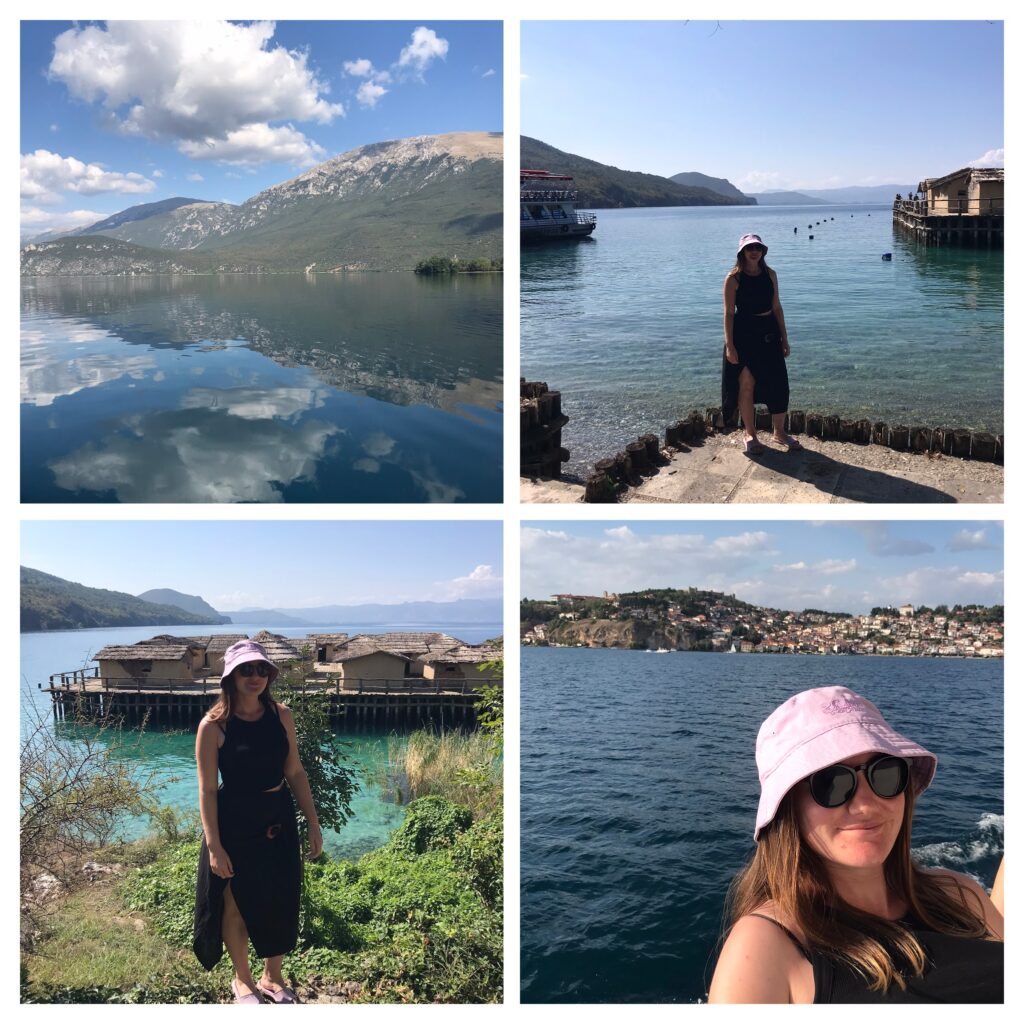
Next was the main attraction, St Naum. We decided to get away from the crowds by first completing the circuit hike around the springs, starting at the Church of Saint Petka and circling round to the Church of the Holy Mother of God (a tiny church close to the edge of the springs) and the Church of Saint Athanasius (a tranquil church with beautiful gardens, we only got a quick look at the church before a lady told us we couldn’t go any further). It was an easy, relatively flat hike. St Naum itself is a large complex including a hotel and Orthodox church. We even spotted some nuns in the monastery complex. The church has some fascinating frescos of saints inside, well worth paying the entry fee. We noticed that there were quite a lot of people praying inside as it’s a pilgrimage site, so please be respectful of their faith. For the remaining time you have at St Naum it’s possible to relax on the beach (make sure you bring your swim stuff) or jump on another boat trip around the springs. Keep an eye out around the grounds for the rogue peacock, there’s even a sign warning of the dangers of the peacock!
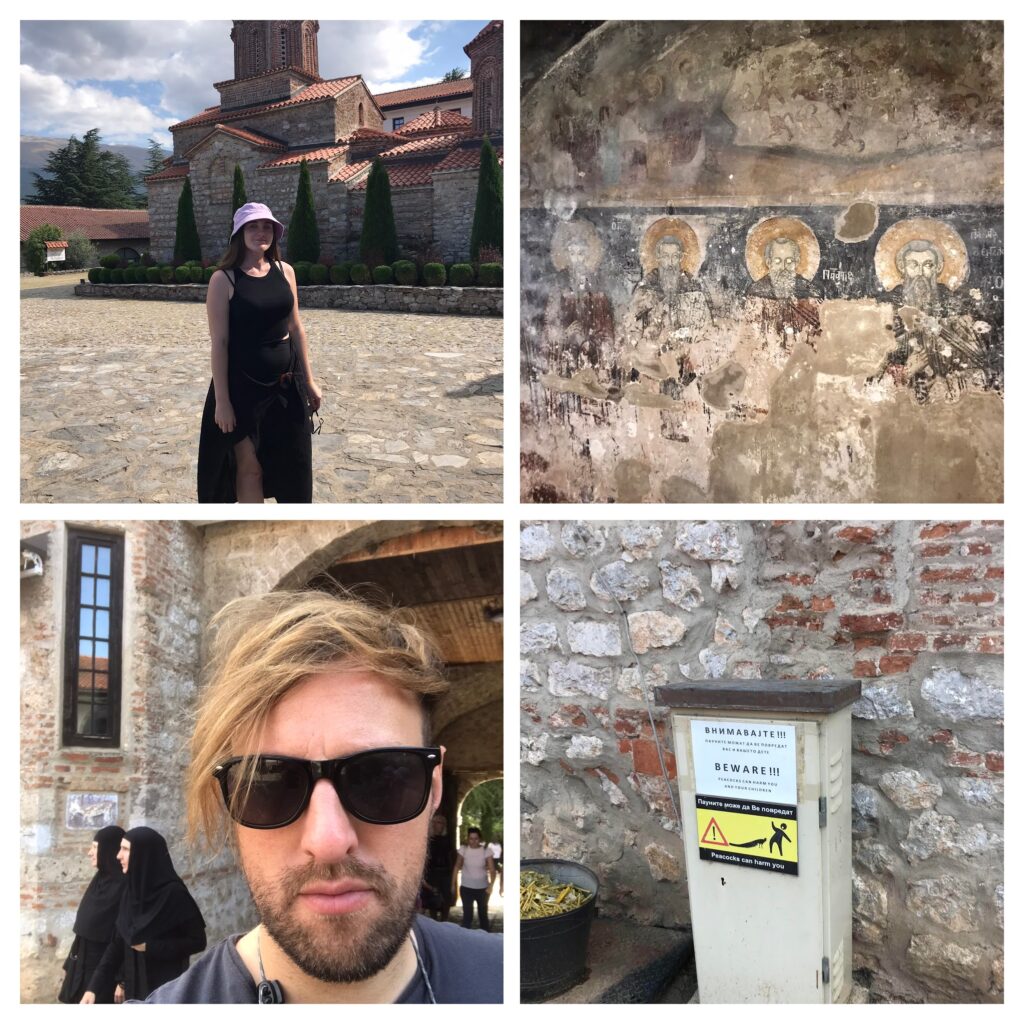
Monastery Wine Tasting booked through Tripadvisor – a relatively new winery situated close to Ohrid, what’s not to love about drinking wine and nibbling charcuterie. The Sommelier walked us through the wine-making process; we even enjoyed a rakia to finish the tasting.
